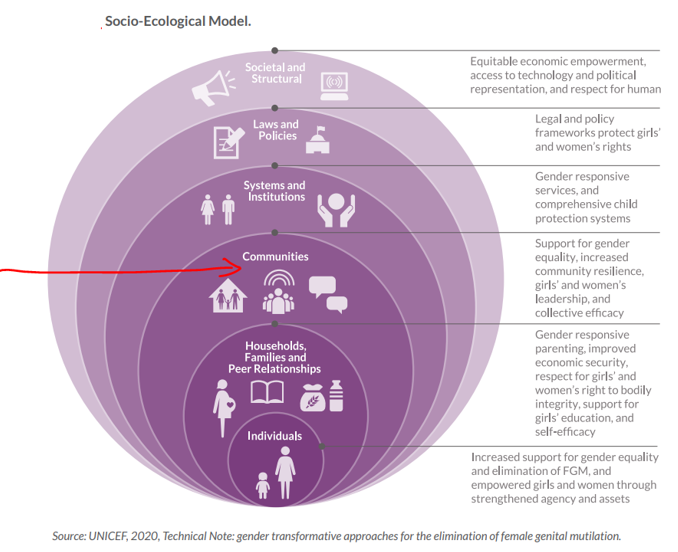The Community Gender Transformative Approach is part of the overall Gender Transformative Approach to end FGM, as shown in the diagram opposite.
The community gender-transformative approach aims to deconstruct stereotypes, to become aware of how we have been socialised and of the roles expected by society in order to realise the inequalities of power and discrimination that this entails.
The community gender transformative approach is a component of this approach, as it is based on the fact that the change resulting from this awareness leads to listening, respect between the sexes, equality between men and women and a reduction in violence against women, including FGM.
Change can take place at individual level, but also at structural and societal level (work, school, institutions, etc.).
The socio-ecological model of gender transformative approaches describes 6 levels, and it is important to have a coordinated approach on the different levels for a lasting impact via a set of actions. The actions implemented in the Community Gender Transformative Approach cover levels 1 (individuals), level 2 (households, families and peer relationships) and level 3 (communities).
Societal change is dynamic and long-term, involving many actors and an interdependent process. The Community Gender Transformative Approach (ACT) to ending female genital mutilation and gender-based violence is one way of finding solutions to complex social problems. In its most basic form, it involves programmes and interventions that create opportunities for individuals to actively challenge traditional norms and address power inequalities within communities. Female genital mutilation (FGM) is closely linked to unequal power relations between men and women and is a form of gender-based violence (GBV).
This approach consists of three steps. These three steps have been developed, implemented, and validated over the course of several cycles of action research carried out in Guinea Conakry, particularly in the Mamou and N’zérékoré regions.
The ‘’Community Gender Transformative Approach’’ involves training facilitators from communities affected by female genital mutilation. They will be responsible for leading dialogue sessions where there is no gender or generation mix (to encourage discussions). These community dialogue sessions will address relations between men and women, the way in which we have been socialised, questions of sexuality and pleasure (to make the link with the impact of FGM), sexual and reproductive rights and gender-based violence. The dialogue sessions take place every 15 days. During this period, participants are invited to talk to at least 5 people in their neighbourhood to spread the messages and have an impact on the community.
At the end of the 7 dialogue sessions, the 4 groups are invited to come together to share their experiences during the sessions, the changes they have seen in themselves, their families, and the community. Together, the participants prepare important messages to share with the local authorities, and a feedback day is organised with the authorities, where the participants give their views. The authorities are also invited to get involved, as some of the actions and recommendations are at institutional level.
The UNFPA technical note entitled “Gender transformative approaches to achieve gender equality and sexualand reproductive
health and rights” states that gender equality is intrinsically linked to sexual and reproductive health and rights (SRHR). Gender inequalities and negative masculinities contribute to high rates of violence; around 30% of women worldwide have experienced physical and/or sexual violence from an intimate partner or non-partner-related sexual violence in their lifetime.
Positive masculinities, as opposed to harmful masculinities, support healthy, non-discriminatory behaviours and societies that advance gender equality and the actions and rights of women and girls. Promoting positive masculinities requires a partnership with men and boys. According to the Interagency Working Group on Gender, 2010. Bartel and Greene, 2018, gender transformative efforts that reach both men and women, boys, and girls, are sometimes referred to as synchronised gender approaches.
The Community Gender Transformative Approach contributes to gender transformation by raising awareness about inequalities within society, including legislation, norms, and stereotypes about what it means to be a man or a woman, harmful masculinities and insufficient support for women’s agency and rights.
This contribution can be achieved through four levers of change in society:
- Firstly, it is necessary to change and transform the harmful attitudes, ideas and norms that prevail in relation to gender equality, poverty and the right to sexual and reproductive health and rights (SRHR), as held by political decision-makers, the political class (their constituencies and their parties);
- Secondly, there is a need to strengthen political commitment, institutional capacity and accountability for gender equality;
- Thirdly, there is a need to ensure adequate, sustainable and gender-sensitive funding.
- Finally, it is important to amplify and develop the voice and capacity of civil society organisations to integrate transformative approaches to gender equality into all aspects of their programming and policy, including programme design, implementation and evaluation.
Changing individual attitudes may not be enough to change behaviour; the Community Gender Transformative Approach has huge potential to engage the community through initiatives aimed at changing social norms. Community-based interventions often include elements to mobilise specific individuals (change agents) within a community to encourage others to change, by promoting dialogue and disseminating messages to people other than the direct participants.
A lot of organisations are calling for profound change and are currently testing new approaches to working on gender relations, through Gender Transformative approaches that include men and attempt to deconstruct gender stereotypes and issues of power and domination linked to patriarchal society. This can be done at individual level, but the most sustainable approach is to integrate this gender approach into the school curriculum from a very early age and later into the world of work. The experience of FAWE (the Forum for African Women Educationalists) in supporting centres of excellence (schools with a gender approach to promote gender equality) is a tried and tested approach that deserves to be scaled up. Local initiatives led by young people using ICTs should also be supported, as it is future generations who, mobilised in this way, will be the actors/actresses of change (Barry, AAB 2017).
The Community Gender Transformative Approach is therefore a tool that also fosters the involvement of men and young boys in fact, during the last International Stakeholder Dialogue on Gender Transformative Approaches to End FGM (ISD), we were able to note that interventions at community level are very often applied in the context of FGM. ISD participants reported adopting approaches in which observation of communities and their internal gender norms was used as a basis for delivering tailored training on human rights and equality and sessions in which men were encouraged to listen to the experiences of women in their communities. Others are adopting a community empowerment approach that defines the role of each community member in the process of abandoning FGM, empowering women and girls to assert themselves against the practice from their position within the community and encouraging men to be the guarantors of cultural and normative change in relation to the practice.
A series of challenges hindering the implementation of a gender transformative approach to end FGM as well as gaps in current efforts have been identified such as resistance from educators, parents and religious and community leaders, fear of project implementers and community members to provoke tensions or conflicts by raising uncomfortable topics, such as: FGM or gender norms, the difficulty of challenging customs and traditions within communities as well as the particularly taboo subjects of sexuality and FGM, communicating what a Community Gender Transformative Approach is,… The Community Gender Transformative Approach provides a response to these challenges through its method, which places the communities concerned at the centre.

